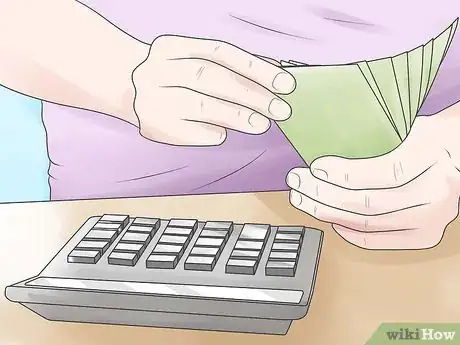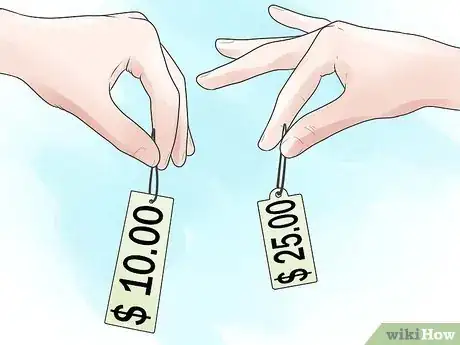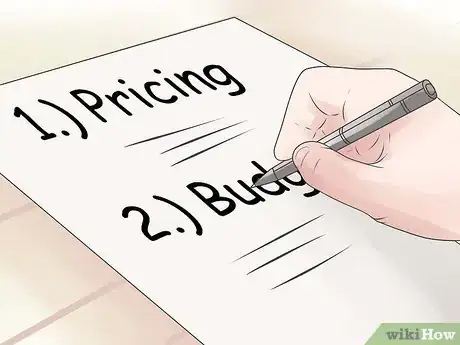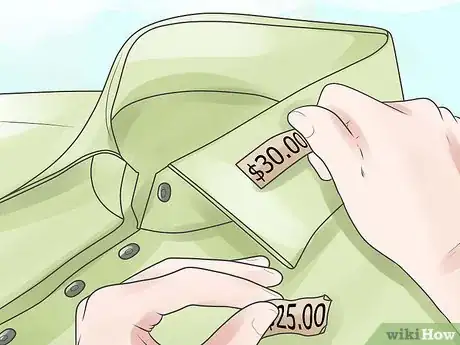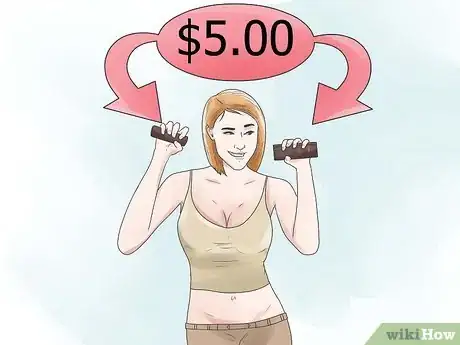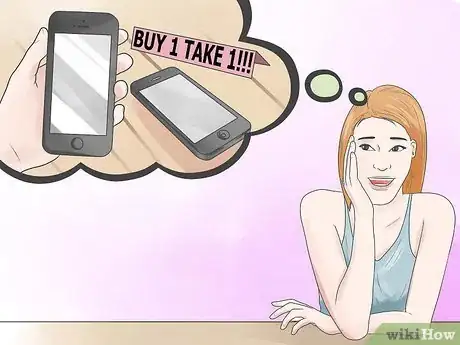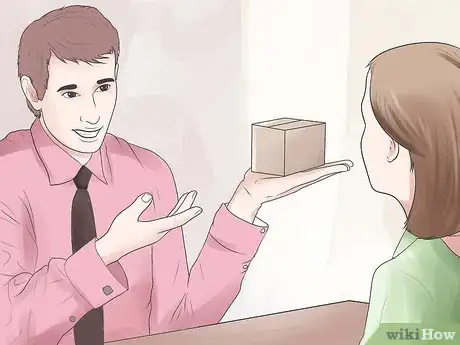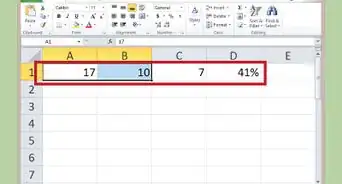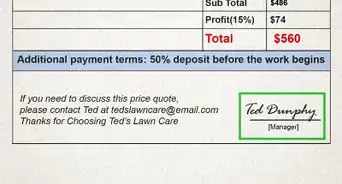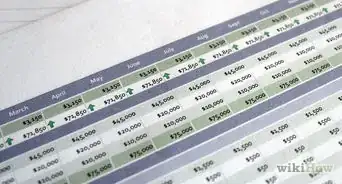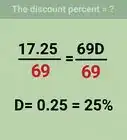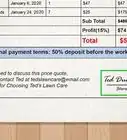This article was co-authored by Archana Ramamoorthy, MS. Archana Ramamoorthy is the Chief Technology Officer, North America at Workday She is a product ninja, security advocate, and on a quest to enable more inclusion in the tech industry. Archana received her BS from SRM University and MS from Duke University and has been working in product management for over 8 years.
There are 15 references cited in this article, which can be found at the bottom of the page.
wikiHow marks an article as reader-approved once it receives enough positive feedback. In this case, several readers have written to tell us that this article was helpful to them, earning it our reader-approved status.
This article has been viewed 150,950 times.
Using an effective pricing strategy can be the difference between a hopping business and a dud. You've already done the work to come up with a killer product and an unforgettable hook for your business, so now you just need to price it accordingly. Learn to determine your overhead, raise and lower appropriately, and use promotional pricing to your advantage, and you'll be in the black in no time.
Steps
Determining Overhead and Pricing Products
-
1Calculate the cost of running your business. A basic pricing method requires that you determine the full cost of running your business and price your product in such a way as to keep your business in the black. So, the first thing you need to do is calculate how much it costs to run your business. These costs can be further divided into direct and indirect costs. Add up your:[1]
-
Direct costs are those which are immediately associated with doing business. These costs get directly assigned to your products and services you provide.[2]
- Labor costs
- Marketing costs
- Manufacturing costs (cost of raw materials, equipment, etc.)
-
Indirect costs are things associated with keeping things running, and the day to day. These are sometimes thought of as the hidden or even “true cost” of running a business.[3]
- Operating expenses (including rent on your building, utilities, etc.)
- Debt service costs
- Return on any investment capital
- Cleaning and office supplies
- Your own salary
-
Direct costs are those which are immediately associated with doing business. These costs get directly assigned to your products and services you provide.[2]
-
2Set a "success point." The only reason to start a business is to make money, and specifically to make enough money to keep the venture a successful enterprise. For this reason, you need to set a point at which you would consider the business successful, your success point, and add that figure to your expenses to determine how much revenue you need to generate from sales.
- Once you know how much money you need to make for the business to be successful, then you can start getting some sense of what a successful price would be for your product.
- It may take some number of years to master your market.
Advertisement -
3Anticipate your customer's desires and how many units you’ll sell. Another major figure that you need to determine is how much merchandise you might reliably sell in a given period. This will be determined by your customers' buying tendencies. Identify your customer base and their buying tendencies.[4] How much do they desire your particular product? Is there a demand for it? Be as specific as possible in your discussion of numbers. How much is it possible to sell, given your current resources? How much do you need to sell to maintain the visibility and success of your current model? What might need to be changed?
- Provide genuine customer service, not just lip service.[5]
-
4Determine the price you need to set to meet your success criteria. Divide your success point by the number of units you think might be reliably sold to determine a price guideline, per unit. This isn't necessarily to say that this should be the price, but this is a good number to start experimenting with and seeing how your customers will respond.
- For instance, if you’ll have $60,000 of operating and manufacturing costs per year and want to bring in $40,000 of revenue, your success point is $100,000. If you think you can sell 6,000 units, that means your price per product should be at least $100,000/6,000 which is $16.67 per unit.
-
5Study your competition. If you sell custom-made iPhone cases, are there other companies that provide similar services? Where? How much do their products cost? How is their company run? You need to learn everything you can about your competition so you can learn to differentiate yourself from their model to get your share of the common market.[6]
- Say you're one of two frozen yogurt stands in your town, and you can't figure out why your $7 a cup (cheap for the ingredients!) organic coconut rosemary kefir isn't bringing in the masses, while the "Dairy Queen" across town sells regular chocolate cones like they're going out of style. You need to be familiar with their prices and their customer base so you can stay competitive and stay relevant. Do you share the same customer base? Is there another customer base you might tap into and market to, to make your business more viable? Is anyone ever going to be willing to pay your prices? These are important questions for a successful business to consider when pricing.
- Use a search engine to research your competition. Social media and the internet have changed the ways customers find business.[7]
Raising and Lowering Prices
-
1Understand the effects of over and under pricing. Setting the price inefficiently will have marked and measurable effects on your numbers. You need to learn to recognize the symptoms of having either a low or high price point. This can indicate that you may need to make a change.
- Underpricing is often done by companies who want to sell a higher volume, expecting that the customer will assume they're getting a deal, especially in a down economy.[8] Doing this, however, can give the impression that the product is "cheap," not that they're getting their money's worth.
- Overpricing may drive your customers elsewhere. Especially when you're trying to get your feet on the ground as your business gets started, it can be tempting to set the price too high. The investment of starting a business can be scary and you'll probably want to start covering costs right away, but consider the customer's point of view. Setting it at a point you'll make money will only work if people are willing to pay for it.[9]
-
2Keep a close eye on your pricing and your budget. Monitor your profits and prices at least monthly. Break down the cost/gains of every product so that you know how each contributes to your overall profitability month-to-month. This can give a clear picture of your money flow.
- Talk to your customers and listen to their feedback. Take it to heart. If they enjoy your product but complain about the price, you might consider making a change.
- Develop a budget plan. Try to focus on a long term strategy that will result in making the business profitable. This might not involve making drastic changes right away, but slowly moving toward an overall goal of profitability.
-
3Raise prices slowly and incrementally. Jumping from selling an iPhone case for $5 to selling one for $12 will undoubtedly lose you customers, even if the price change is right for the business and a smart move. Instead, raise it incrementally and spend time advertising the product's benefits and advantages, as opposed to apologizing for the increase. Treat it as a benefit, rather than an inconvenience.
- Sudden increases will look like desperate moves made by a struggling business, which may or may not be true. You want to avoid the impression that you're raising the prices because you need to make more money. Rather, you need to make it seem as if you're raising prices because the product is just that good.[10]
- Watch your sales volume immediately after making the change. If the move was too sudden, you'll see a negative change, suggesting that you need to do more to sell the new variation on the product and justify its price.
-
4Use promotions to lower prices and get people in the store. Unless your competition is lowering their price, or you're just not getting the kind of traffic in your business that you need in order to make it profitable, you generally want to avoid lowering prices. Lowering the price may suggest another kind of desperation--that people are avoiding your store. Using promotions for limited periods of time, or coupons that expire, you can help drive customers toward a particular product or service.
- Use discount tactics and promotions rather than lowering the price all at once. You can even alter the amount that someone gets for the same price. For example, November is a month of diabetes awareness.[11] During November, you may charge more for sugary drinks and to recoup the cost of charging less on healthy foods. Make sure to the customers about this, as it can help to drive their choices, as well as make them feel better about paying more for something. They will also know that the price changes are limited.
- Avoid seeming desperate. For example, an empty restaurant may give the impression that the food is not delicious. Especially if it suddenly becomes very cheap, people may feel the product is of inferior quality.
Using Promotional Pricing Strategies
-
1Use creative promotions to get people in the door. Pricing in order to promote a product is a very common application. This gives the consumer the impression that your business is a place to go to get deals, even if you're not always giving them deals. Try letting your pricing strategies advertise for you.
- Use a Buy One, Get One Free promotion to get people interested in your product and ensure that they'll be struck by the deals they're getting. If you can keep them coming back, even when you're not holding promotions, they'll be hooked.
- Often sellers will bundle several products in the same package, moving old or unwanted stock by creating killer deals. Dated DVDs, CDs, and video games are often sold using the bundle approach.
- Quantity discounts (20% off $150 or more!) and rebates ($399.95 after rebate!) can also help to get people to purchase more.[12]
-
2Appeal to your customer's emotions and rationality. Promotional pricing strategies can't just be informational campaigns, they have to connect with your target market.[13] In order to do this, take time to appeal to their emotions or pragmatism. A common business strategy involves pricing items in .99 cent increments, rather than dollar increments. At a glance, the difference in savings seems huge (even though it's non-existent, practically). Pricing judiciously will help you keep sales high without changing your strategy considerably.
- Consider creating a "Premium" package to up-sell customers on moderately "improved" versions of the basically the same product, but with more sophistication (i.e., more marketing).
- Consider establishing a "line" of products, with varying levels at which the customer can engage. Car washes will often use this pricing strategy: A basic wash could be $2, wash and wax $4, and the whole package $6.
-
3Try to up-sell promotions to move more merchandise. In Optional Product pricing, companies will attempt to increase the amount customers spend once they start to buy. Optional 'extras' increase the overall price of the product or service. For example, airlines will charge for optional extras such as guaranteeing a window seat or reserving a row of seats next to each other.
-
4Avoid the appearance of price gouging. Gouging involves raising your product to a high price because you have a substantial competitive advantage of some kind, or a corner of the market. This advantage is not sustainable. The high price tends to attract new competitors into the market, and the price inevitably falls due to increased supply.
- Captive Product Pricing is used when products have complements. Companies will charge a premium price where the consumer is captured. For example, a razor manufacturer will charge a low price and recoup its margin (and more) from the sale of the only design of blades which fit the razor.
- In some places or under certain circumstances, price gouging is unlawful.[16] [17]
Expert Q&A
Did you know you can get expert answers for this article?
Unlock expert answers by supporting wikiHow
-
QuestionHow do you price items?
 Archana Ramamoorthy, MSArchana Ramamoorthy is the Chief Technology Officer, North America at Workday She is a product ninja, security advocate, and on a quest to enable more inclusion in the tech industry. Archana received her BS from SRM University and MS from Duke University and has been working in product management for over 8 years.
Archana Ramamoorthy, MSArchana Ramamoorthy is the Chief Technology Officer, North America at Workday She is a product ninja, security advocate, and on a quest to enable more inclusion in the tech industry. Archana received her BS from SRM University and MS from Duke University and has been working in product management for over 8 years.
Product Management Specialist Your expenses should help you determine your pricing model. When it comes to monetization, think about the most important expense you have in building that product. Then, try to see how you can offset those costs by charging for your product. For instance, if you're spending most of your resources on compute power, your pricing strategy might be based on the number of users on your platform.
Your expenses should help you determine your pricing model. When it comes to monetization, think about the most important expense you have in building that product. Then, try to see how you can offset those costs by charging for your product. For instance, if you're spending most of your resources on compute power, your pricing strategy might be based on the number of users on your platform. -
QuestionHow do you create a pricing strategy?
 Archana Ramamoorthy, MSArchana Ramamoorthy is the Chief Technology Officer, North America at Workday She is a product ninja, security advocate, and on a quest to enable more inclusion in the tech industry. Archana received her BS from SRM University and MS from Duke University and has been working in product management for over 8 years.
Archana Ramamoorthy, MSArchana Ramamoorthy is the Chief Technology Officer, North America at Workday She is a product ninja, security advocate, and on a quest to enable more inclusion in the tech industry. Archana received her BS from SRM University and MS from Duke University and has been working in product management for over 8 years.
Product Management Specialist Before you think about the pricing, look at the core of how you'll monetize. For instance, if users are central to your monetizing strategy, you'll want to make sure that version one of your product gets users and keeps them for as long as possible. You can focus on the pricing model once you've accomplished that. However, if you're offering something completely revolutionary in your industry, you'll want to be strategic about monetizing from the beginning.
Before you think about the pricing, look at the core of how you'll monetize. For instance, if users are central to your monetizing strategy, you'll want to make sure that version one of your product gets users and keeps them for as long as possible. You can focus on the pricing model once you've accomplished that. However, if you're offering something completely revolutionary in your industry, you'll want to be strategic about monetizing from the beginning. -
QuestionHow important is pricing?
 Archana Ramamoorthy, MSArchana Ramamoorthy is the Chief Technology Officer, North America at Workday She is a product ninja, security advocate, and on a quest to enable more inclusion in the tech industry. Archana received her BS from SRM University and MS from Duke University and has been working in product management for over 8 years.
Archana Ramamoorthy, MSArchana Ramamoorthy is the Chief Technology Officer, North America at Workday She is a product ninja, security advocate, and on a quest to enable more inclusion in the tech industry. Archana received her BS from SRM University and MS from Duke University and has been working in product management for over 8 years.
Product Management Specialist
Warnings
- Lowering price way below the average market price may present your product as inferior.⧼thumbs_response⧽
References
- ↑ https://www.business.qld.gov.au/business/starting/starting-a-business/calculating-your-costs-when-starting-a-business
- ↑ http://www.businessnewsdaily.com/5498-direct-costs-indirect-costs.html
- ↑ http://www.businessnewsdaily.com/5498-direct-costs-indirect-costs.html
- ↑ http://www.forbes.com/sites/carminegallo/2014/05/28/stop-listening-and-start-anticipating-your-customers-needs/
- ↑ http://www.forbes.com/sites/pega/2015/05/18/anticipating-what-customers-need-without-the-creep-factor/
- ↑ http://www.inc.com/guides/price-your-products.html
- ↑ http://business.time.com/2012/08/16/learn-from-your-competitors/
- ↑ https://www.iwu.edu/economics/PPE08/peter.pdf
- ↑ https://www.ocregister.com/2009/08/13/dont-make-the-mistake-of-overpricing-your-home/
- ↑ http://www.businessinsider.com/3-powerful-pricing-strategies-businesses-should-always-consider-2013-10
- ↑ http://healthfinder.gov/nho/
- ↑ http://www.volusion.com/ecommerce-blog/articles/using-the-psychology-of-discounts-to-make-more-money/
- ↑ http://papers.ssrn.com/sol3/papers.cfm?abstract_id=1983320
- ↑ https://hbr.org/1990/09/the-double-jeopardy-of-sales-promotions
- ↑ https://hbr.org/1990/09/the-double-jeopardy-of-sales-promotions
- ↑ http://www.doj.state.or.us/consumer/Pages/price_gouging.aspx
- ↑ http://myfloridalegal.com/pages.nsf/Main/5D2710E379EAD6BC85256F03006AA2C5?OpenDocument
About This Article
To price a product you're selling, start by calculating the cost of running your business, which should include the cost of labor, marketing, manufacturing, and any indirect costs. Then, determine how much money you'd need to earn to make a profit and be successful. Once you know how much money you need to earn, use that number to help you set a reasonable price for your product. You can also look at your competition's prices to get an idea of what people are willing to pay. If your product is in high demand, try setting your prices a little higher. To learn how to raise and lower your prices successfully, scroll down!
